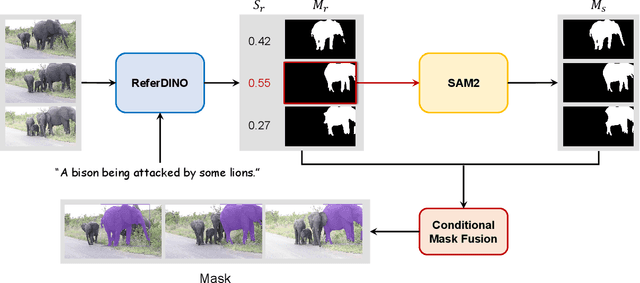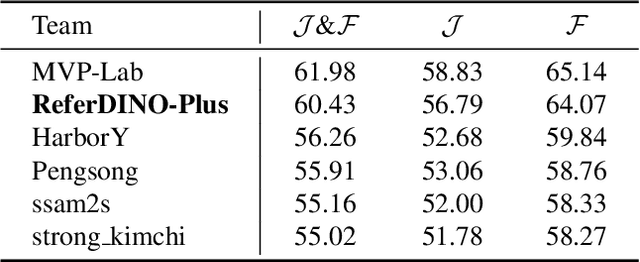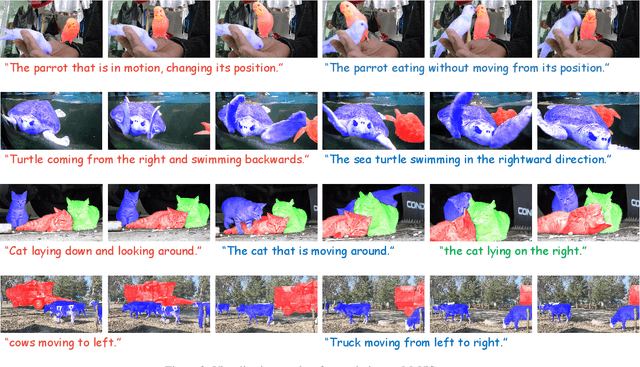Jian-Fang Hu
CoopDiff: Anticipating 3D Human-object Interactions via Contact-consistent Decoupled Diffusion
Aug 10, 2025Abstract:3D human-object interaction (HOI) anticipation aims to predict the future motion of humans and their manipulated objects, conditioned on the historical context. Generally, the articulated humans and rigid objects exhibit different motion patterns, due to their distinct intrinsic physical properties. However, this distinction is ignored by most of the existing works, which intend to capture the dynamics of both humans and objects within a single prediction model. In this work, we propose a novel contact-consistent decoupled diffusion framework CoopDiff, which employs two distinct branches to decouple human and object motion modeling, with the human-object contact points as shared anchors to bridge the motion generation across branches. The human dynamics branch is aimed to predict highly structured human motion, while the object dynamics branch focuses on the object motion with rigid translations and rotations. These two branches are bridged by a series of shared contact points with consistency constraint for coherent human-object motion prediction. To further enhance human-object consistency and prediction reliability, we propose a human-driven interaction module to guide object motion modeling. Extensive experiments on the BEHAVE and Human-object Interaction datasets demonstrate that our CoopDiff outperforms state-of-the-art methods.
Long-RVOS: A Comprehensive Benchmark for Long-term Referring Video Object Segmentation
May 19, 2025Abstract:Referring video object segmentation (RVOS) aims to identify, track and segment the objects in a video based on language descriptions, which has received great attention in recent years. However, existing datasets remain focus on short video clips within several seconds, with salient objects visible in most frames. To advance the task towards more practical scenarios, we introduce \textbf{Long-RVOS}, a large-scale benchmark for long-term referring video object segmentation. Long-RVOS contains 2,000+ videos of an average duration exceeding 60 seconds, covering a variety of objects that undergo occlusion, disappearance-reappearance and shot changing. The objects are manually annotated with three different types of descriptions to individually evaluate the understanding of static attributes, motion patterns and spatiotemporal relationships. Moreover, unlike previous benchmarks that rely solely on the per-frame spatial evaluation, we introduce two new metrics to assess the temporal and spatiotemporal consistency. We benchmark 6 state-of-the-art methods on Long-RVOS. The results show that current approaches struggle severely with the long-video challenges. To address this, we further propose ReferMo, a promising baseline method that integrates motion information to expand the temporal receptive field, and employs a local-to-global architecture to capture both short-term dynamics and long-term dependencies. Despite simplicity, ReferMo achieves significant improvements over current methods in long-term scenarios. We hope that Long-RVOS and our baseline can drive future RVOS research towards tackling more realistic and long-form videos.
PVUW 2025 Challenge Report: Advances in Pixel-level Understanding of Complex Videos in the Wild
Apr 15, 2025



Abstract:This report provides a comprehensive overview of the 4th Pixel-level Video Understanding in the Wild (PVUW) Challenge, held in conjunction with CVPR 2025. It summarizes the challenge outcomes, participating methodologies, and future research directions. The challenge features two tracks: MOSE, which focuses on complex scene video object segmentation, and MeViS, which targets motion-guided, language-based video segmentation. Both tracks introduce new, more challenging datasets designed to better reflect real-world scenarios. Through detailed evaluation and analysis, the challenge offers valuable insights into the current state-of-the-art and emerging trends in complex video segmentation. More information can be found on the workshop website: https://pvuw.github.io/.
Modeling Multiple Normal Action Representations for Error Detection in Procedural Tasks
Apr 02, 2025



Abstract:Error detection in procedural activities is essential for consistent and correct outcomes in AR-assisted and robotic systems. Existing methods often focus on temporal ordering errors or rely on static prototypes to represent normal actions. However, these approaches typically overlook the common scenario where multiple, distinct actions are valid following a given sequence of executed actions. This leads to two issues: (1) the model cannot effectively detect errors using static prototypes when the inference environment or action execution distribution differs from training; and (2) the model may also use the wrong prototypes to detect errors if the ongoing action label is not the same as the predicted one. To address this problem, we propose an Adaptive Multiple Normal Action Representation (AMNAR) framework. AMNAR predicts all valid next actions and reconstructs their corresponding normal action representations, which are compared against the ongoing action to detect errors. Extensive experiments demonstrate that AMNAR achieves state-of-the-art performance, highlighting the effectiveness of AMNAR and the importance of modeling multiple valid next actions in error detection. The code is available at https://github.com/iSEE-Laboratory/AMNAR.
ReferDINO-Plus: 2nd Solution for 4th PVUW MeViS Challenge at CVPR 2025
Mar 30, 2025



Abstract:Referring Video Object Segmentation (RVOS) aims to segment target objects throughout a video based on a text description. This task has attracted increasing attention in the field of computer vision due to its promising applications in video editing and human-agent interaction. Recently, ReferDINO has demonstrated promising performance in this task by adapting object-level vision-language knowledge from pretrained foundational image models. In this report, we further enhance its capabilities by incorporating the advantages of SAM2 in mask quality and object consistency. In addition, to effectively balance performance between single-object and multi-object scenarios, we introduce a conditional mask fusion strategy that adaptively fuses the masks from ReferDINO and SAM2. Our solution, termed ReferDINO-Plus, achieves 60.43 \(\mathcal{J}\&\mathcal{F}\) on MeViS test set, securing 2nd place in the MeViS PVUW challenge at CVPR 2025. The code is available at: https://github.com/iSEE-Laboratory/ReferDINO-Plus.
ViSpeak: Visual Instruction Feedback in Streaming Videos
Mar 17, 2025



Abstract:Recent advances in Large Multi-modal Models (LMMs) are primarily focused on offline video understanding. Instead, streaming video understanding poses great challenges to recent models due to its time-sensitive, omni-modal and interactive characteristics. In this work, we aim to extend the streaming video understanding from a new perspective and propose a novel task named Visual Instruction Feedback in which models should be aware of visual contents and learn to extract instructions from them. For example, when users wave their hands to agents, agents should recognize the gesture and start conversations with welcome information. Thus, following instructions in visual modality greatly enhances user-agent interactions. To facilitate research, we define seven key subtasks highly relevant to visual modality and collect the ViSpeak-Instruct dataset for training and the ViSpeak-Bench for evaluation. Further, we propose the ViSpeak model, which is a SOTA streaming video understanding LMM with GPT-4o-level performance on various streaming video understanding benchmarks. After finetuning on our ViSpeak-Instruct dataset, ViSpeak is equipped with basic visual instruction feedback ability, serving as a solid baseline for future research.
Progressive Human Motion Generation Based on Text and Few Motion Frames
Mar 17, 2025



Abstract:Although existing text-to-motion (T2M) methods can produce realistic human motion from text description, it is still difficult to align the generated motion with the desired postures since using text alone is insufficient for precisely describing diverse postures. To achieve more controllable generation, an intuitive way is to allow the user to input a few motion frames describing precise desired postures. Thus, we explore a new Text-Frame-to-Motion (TF2M) generation task that aims to generate motions from text and very few given frames. Intuitively, the closer a frame is to a given frame, the lower the uncertainty of this frame is when conditioned on this given frame. Hence, we propose a novel Progressive Motion Generation (PMG) method to progressively generate a motion from the frames with low uncertainty to those with high uncertainty in multiple stages. During each stage, new frames are generated by a Text-Frame Guided Generator conditioned on frame-aware semantics of the text, given frames, and frames generated in previous stages. Additionally, to alleviate the train-test gap caused by multi-stage accumulation of incorrectly generated frames during testing, we propose a Pseudo-frame Replacement Strategy for training. Experimental results show that our PMG outperforms existing T2M generation methods by a large margin with even one given frame, validating the effectiveness of our PMG. Code will be released.
AdvAD: Exploring Non-Parametric Diffusion for Imperceptible Adversarial Attacks
Mar 12, 2025Abstract:Imperceptible adversarial attacks aim to fool DNNs by adding imperceptible perturbation to the input data. Previous methods typically improve the imperceptibility of attacks by integrating common attack paradigms with specifically designed perception-based losses or the capabilities of generative models. In this paper, we propose Adversarial Attacks in Diffusion (AdvAD), a novel modeling framework distinct from existing attack paradigms. AdvAD innovatively conceptualizes attacking as a non-parametric diffusion process by theoretically exploring basic modeling approach rather than using the denoising or generation abilities of regular diffusion models requiring neural networks. At each step, much subtler yet effective adversarial guidance is crafted using only the attacked model without any additional network, which gradually leads the end of diffusion process from the original image to a desired imperceptible adversarial example. Grounded in a solid theoretical foundation of the proposed non-parametric diffusion process, AdvAD achieves high attack efficacy and imperceptibility with intrinsically lower overall perturbation strength. Additionally, an enhanced version AdvAD-X is proposed to evaluate the extreme of our novel framework under an ideal scenario. Extensive experiments demonstrate the effectiveness of the proposed AdvAD and AdvAD-X. Compared with state-of-the-art imperceptible attacks, AdvAD achieves an average of 99.9$\%$ (+17.3$\%$) ASR with 1.34 (-0.97) $l_2$ distance, 49.74 (+4.76) PSNR and 0.9971 (+0.0043) SSIM against four prevalent DNNs with three different architectures on the ImageNet-compatible dataset. Code is available at https://github.com/XianguiKang/AdvAD.
* Accept by NeurIPS 2024. Please cite this paper using the following format: J. Li, Z. He, A. Luo, J. Hu, Z. Wang, X. Kang*, "AdvAD: Exploring Non-Parametric Diffusion for Imperceptible Adversarial Attacks", the 38th Annual Conference on Neural Information Processing Systems (NeurIPS), Vancouver, Canada, Dec 9-15, 2024. Code: https://github.com/XianguiKang/AdvAD
ReferDINO: Referring Video Object Segmentation with Visual Grounding Foundations
Jan 24, 2025



Abstract:Referring video object segmentation (RVOS) aims to segment target objects throughout a video based on a text description. Despite notable progress in recent years, current RVOS models remain struggle to handle complicated object descriptions due to their limited video-language understanding. To address this limitation, we present \textbf{ReferDINO}, an end-to-end RVOS model that inherits strong vision-language understanding from the pretrained visual grounding foundation models, and is further endowed with effective temporal understanding and object segmentation capabilities. In ReferDINO, we contribute three technical innovations for effectively adapting the foundation models to RVOS: 1) an object-consistent temporal enhancer that capitalizes on the pretrained object-text representations to enhance temporal understanding and object consistency; 2) a grounding-guided deformable mask decoder that integrates text and grounding conditions to generate accurate object masks; 3) a confidence-aware query pruning strategy that significantly improves the object decoding efficiency without compromising performance. We conduct extensive experiments on five public RVOS benchmarks to demonstrate that our proposed ReferDINO outperforms state-of-the-art methods significantly. Project page: \url{https://isee-laboratory.github.io/ReferDINO}
SAUGE: Taming SAM for Uncertainty-Aligned Multi-Granularity Edge Detection
Dec 17, 2024Abstract:Edge labels are typically at various granularity levels owing to the varying preferences of annotators, thus handling the subjectivity of per-pixel labels has been a focal point for edge detection. Previous methods often employ a simple voting strategy to diminish such label uncertainty or impose a strong assumption of labels with a pre-defined distribution, e.g., Gaussian. In this work, we unveil that the segment anything model (SAM) provides strong prior knowledge to model the uncertainty in edge labels. Our key insight is that the intermediate SAM features inherently correspond to object edges at various granularities, which reflects different edge options due to uncertainty. Therefore, we attempt to align uncertainty with granularity by regressing intermediate SAM features from different layers to object edges at multi-granularity levels. In doing so, the model can fully and explicitly explore diverse ``uncertainties'' in a data-driven fashion. Specifically, we inject a lightweight module (~ 1.5% additional parameters) into the frozen SAM to progressively fuse and adapt its intermediate features to estimate edges from coarse to fine. It is crucial to normalize the granularity level of human edge labels to match their innate uncertainty. For this, we simply perform linear blending to the real edge labels at hand to create pseudo labels with varying granularities. Consequently, our uncertainty-aligned edge detector can flexibly produce edges at any desired granularity (including an optimal one). Thanks to SAM, our model uniquely demonstrates strong generalizability for cross-dataset edge detection. Extensive experimental results on BSDS500, Muticue and NYUDv2 validate our model's superiority.
 Add to Chrome
Add to Chrome Add to Firefox
Add to Firefox Add to Edge
Add to Edge